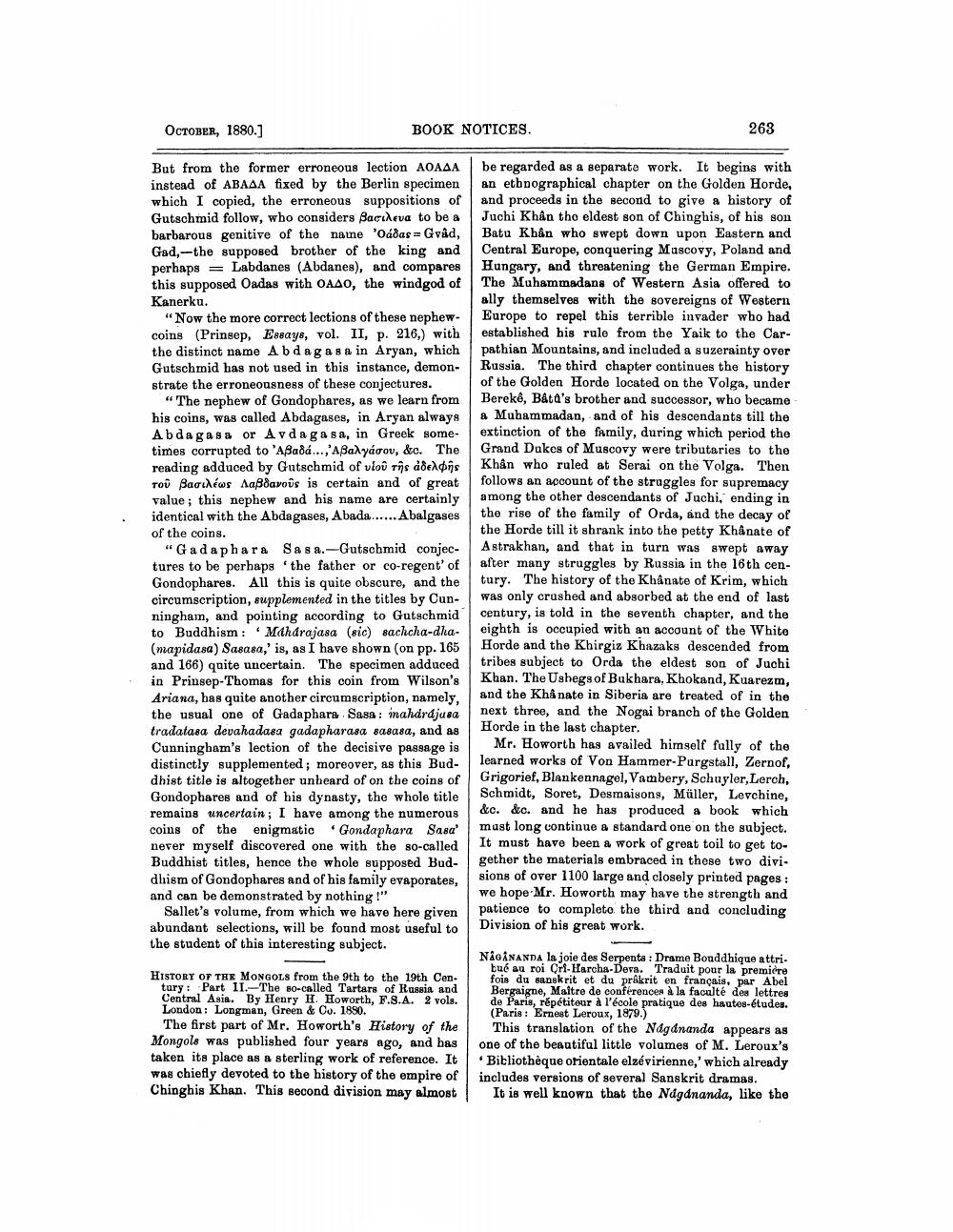________________
BOOK NOTICES.
OCTOBER, 1880.]
But from the former erroneous lection AOAAA instead of ABAAA fixed by the Berlin specimen which I copied, the erroneous suppositions of Gutschmid follow, who considers Barileva to be a barbarous genitive of the name 'Oádas Gvâd, Gad, the supposed brother of the king and perhaps Labdanes (Abdanes), and compares this supposed Oadas with OAAO, the windgod of Kanerku.
=
"Now the more correct lections of these nephewcoins (Prinsep, Essays, vol. II, p. 216,) with the distinct name Abdagasa in Aryan, which Gutschmid has not used in this instance, demonstrate the erroneousness of these conjectures.
"The nephew of Gondophares, as we learn from his coins, was called Abdagases, in Aryan always Abdagasa or Avdagasa, in Greek sometimes corrupted to 'Aßadá...,'Aßaλyárov, &c. The reading adduced by Gutschmid of υἱοῦ τῆς ἀδελφῆς τοῦ βασιλέως Λαβδανοῦς is certain and of great value; this nephew and his name are certainly identical with the Abdagases, Abada...... Abalgases of the coins.
"Gadaphara Sasa.-Gutschmid conjectures to be perhaps the father or co-regent' of Gondophares. All this is quite obscure, and the circumscription, supplemented in the titles by Cunningham, and pointing according to Gutschmid to Buddhism: Maharajasa (sic) sachcha-dha(mapidasa) Sasasa,' is, as I have shown (on pp. 165 and 166) quite uncertain. The specimen adduced in Prinsep-Thomas for this coin from Wilson's Ariana, has quite another circumscription, namely, the usual one of Gadaphara Sasa: mahárájusa tradatasa devahadasa gadapharasa sasasa, and as Cunningham's lection of the decisive passage is distinctly supplemented; moreover, as this Buddhist title is altogether unheard of on the coins of Gondophares and of his dynasty, the whole title remains uncertain; I have among the numerous coins of the enigmatic Gondaphara Sasa' never myself discovered one with the so-called Buddhist titles, hence the whole supposed Buddhism of Gondophares and of his family evaporates, and can be demonstrated by nothing!"
Sallet's volume, from which we have here given abundant selections, will be found most useful to the student of this interesting subject.
HISTORY OF THE MONGOLS from the 9th to the 19th Century: Part II.-The so-called Tartars of Russia and Central Asia. By Henry H. Howorth, F.S.A. 2 vols. London: Longman, Green & Co. 1880.
The first part of Mr. Howorth's History of the Mongols was published four years ago, and has taken its place as a sterling work of reference. It was chiefly devoted to the history of the empire of Chinghis Khan. This second division may almost
263
be regarded as a separate work. It begins with an ethnographical chapter on the Golden Horde, and proceeds in the second to give a history of Juchi Khân the eldest son of Chinghis, of his son Batu Khân who swept down upon Eastern and Central Europe, conquering Muscovy, Poland and Hungary, and threatening the German Empire. The Muhammadans of Western Asia offered to ally themselves with the sovereigns of Western Europe to repel this terrible invader who had established his rule from the Yaik to the Carpathian Mountains, and included a suzerainty over Russia. The third chapter continues the history of the Golden Horde located on the Volga, under Berekê, Bâta's brother and successor, who became a Muhammadan, and of his descendants till the extinction of the family, during which period the Grand Dukes of Muscovy were tributaries to the Khân who ruled at Serai on the Volga. Then follows an account of the struggles for supremacy among the other descendants of Juchi, ending in the rise of the family of Orda, and the decay of the Horde till it shrank into the petty Khanate of Astrakhan, and that in turn was swept away after many struggles by Russia in the 16th century. The history of the Khânate of Krim, which was only crushed and absorbed at the end of last century, is told in the seventh chapter, and the eighth is occupied with an account of the White Horde and the Khirgiz Khazaks descended from tribes subject to Orda the eldest son of Juchi Khan. The Ushegs of Bukhara, Khokand, Kuarezm, and the Khânate in Siberia are treated of in the next three, and the Nogai branch of the Golden Horde in the last chapter.
Mr. Howorth has availed himself fully of the learned works of Von Hammer-Purgstall, Zernof, Grigorief, Blankennagel, Vambery, Schuyler, Lerch, Schmidt, Soret, Desmaisons, Müller, Levchine, &c. &c. and he has produced a book which must long continue a standard one on the subject. It must have been a work of great toil to get together the materials embraced in these two divisions of over 1100 large and closely printed pages: we hope Mr. Howorth may have the strength and patience to completo the third and concluding Division of his great work.
NAGANANDA la joie des Serpents: Drame Bouddhique attribué au roi Cri-Harcha-Deva. Traduit pour la première fois du sanskrit et du prakrit en français, par Abel Bergaigne, Maître de conférences à la faculté des lettres de Paris, répétiteur à l'école pratique des hautes-études. (Paris: Ernest Leroux, 1879.)
This translation of the Nagdnanda appears as one of the beautiful little volumes of M. Leroux's Bibliothèque orientale elzévirienne,' which already includes versions of several Sanskrit dramas.
It is well known that the Nágánanda, like the




